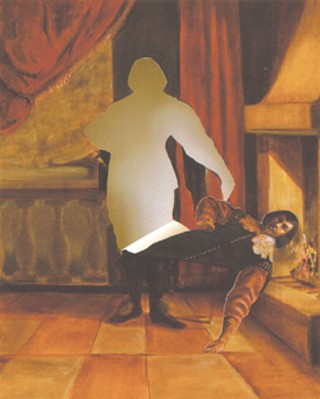THERE IS NO AMBIGUITY or poetic metaphor in the title of this exhibition. It means exactly what it says. Titus Kaphar does his paintings and then, literally, undoes them. He creates parodies of European and American history paintings of the 17th century through the 19th century, and then proceeds to destroy them by cutting, crumpling and partially erasing.
“Conversation Between Paintings, No. 1: Descending From the Cross to be Nourished at the Breast of Our Mother” is made up of two adjacent and stretched canvases. The one on the left is of a woman of African descent sitting in profile facing the painting on the right, which is of a full standing portrait of one of the United States’ founding fathers in 18th century military dress. This is not a copy of a particular portrait, but a composite of Washington, Jefferson and others. Kaphar does not copy but creates works that quote the style and dress of the historical period. In this work, Kaphar has carefully cut around the outline of the male portrait, so that the figure falls out of the canvas to land in the lap of the woman in the adjacent painting. Her arm has been cut so that it embraces the fallen figure. Through the now empty figure-shaped hole he has left behind him, the intersection of the wooden stretcher bars can be seen and read as the cross of the title.
This title raises various interpretations of the narrative. Does the reference to “Our Mother” refer to the African American’s descent from the union of the black slave woman and the white slave owner; or perhaps “Our Mother” refer to everyone’s mother, as recent archaeological research has informed us that all humanity can be traced back to the same few African mothers? And why is the Founding Father descending from the Cross, like Christ? Is a connection being made between Christian fundamentalism and the hyper-nationalism this country’s leaders have chosen?
Christianity is also referenced in “Slippage”, a small chapel installation that is entered through a completely blacked out corridor. In the chapel, there is an altar rail with accompanying kneeler, and where the altar would be, a large canvas has fallen in a crumpled heap. It is difficult to see exactly what the painting depicts as it is so mangled, but it appears to be a European painting of the Crucifixion. Are we here to mourn the end of painting – or the end of religion?
“George, George, George” is a very large, freestanding painting mounted in the center of the gallery, depicting George Washington being rowed across an ice-bound river by an African-American who has been cropped by the left side of the canvas so that only his arms and hands on the oars are visible. The figure of Washington, who stands regally and dominates the entire picture plane, has been cut out, inverted and reapplied to the canvas upside down, leaving areas of space through which a small painting titled “Kindling” can be seen on the far wall. This painting depicts a white man in 17th century dress standing by a fireplace. Kaphar has cut the figure out of the canvas so that it appears to be falling head first into the fire.
Although cutting figures out of the canvas or removing the canvas from the stretchers and crumpling it are the usual methods of “undoing” painting that Kaphar uses, there are two works here that employ other destructions. “Othello,” is a portrait of an African American male that can be detected under a partial coating of whitewash. In another work, a small head and shoulders of a woman wearing an Elizabethan collar is fixed to the top of a vast steel tank encased in black tar. The woman appears to be upper-class and white, but the long, strange title, “I Still Don’t Know How or Why it Ended Like This, But It Began When One of the Older Women Called her Blackness into Question”, suggests another reading.
This is an art about painting, or rather, about raising questions about painting: What do you do with a career in painting when painting is dead? What would happen if a figure stepped out of a painting and entered another? How many ways can a rectangular painting format be deconstructed? How can you present post-colonial critiques of Western culture as subject matter in painting? This is the discourse of graduate painting departments and Kaphar is a recent graduate with an M.F.A. from Yale. But despite the dominance of the ideological theme of racial critique in Kaphar’s work, it is the act of destroying painting that is the true content of the work.
The end of art has been on the agenda for a long time. And it became the central point of the 20th century avant-garde groupings. What people often forget is that it is not the end of creativity that the avant-garde, desired, but the end of a specialized category of art with a capital “A”. For the avant-garde, art was to be made by all, and all daily life was to be made over to total art. But these conditions have not so far arrived and, meanwhile, artists with careers in painting seem to be condemned to the repeated re-enactment of painting’s demise.
‘Painting Undone’ by Titus Kaphar
Where: Red Gallery, 201 E. Broughton St.When: Through April 6
























